Mihun, I'm not sure about the spruce, I'll ask Monday night, our next shop time.
-
Happy Birthday, Lead Belly (1888-1949)! 🎸🕛🪨🏝️
You are using an out of date browser. It may not display this or other websites correctly.
You should upgrade or use an alternative browser.
You should upgrade or use an alternative browser.
Canoe Therapy
- Thread starter Robin
- Start date
We finished the ribs, soaked them, steamed them, and bent them around the canoe yesterday to set up. We started removing a few ribs and today we installed the 12th and final new rib.
I'm off to the toboggan races in Camden, Maine Thursday so Bob will be installing plank then, and next week we should be sanding and varnishing, looking forward to that.
Bob fitting in a new rib
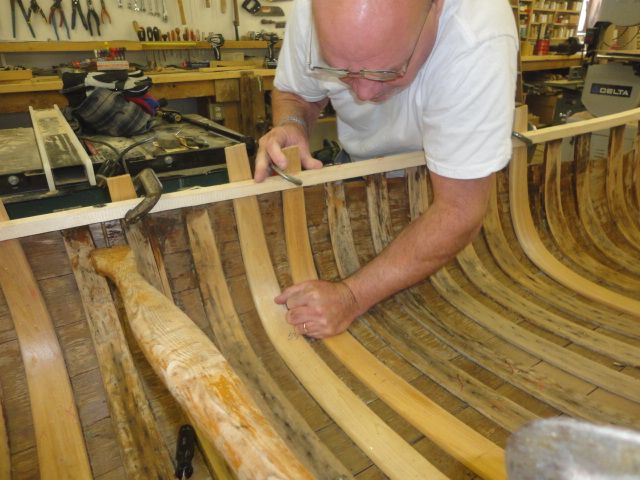
Me hammering in new tacks while Bob held the clinching iron on the inside to clinch the tack onto the new rib inside the canoe
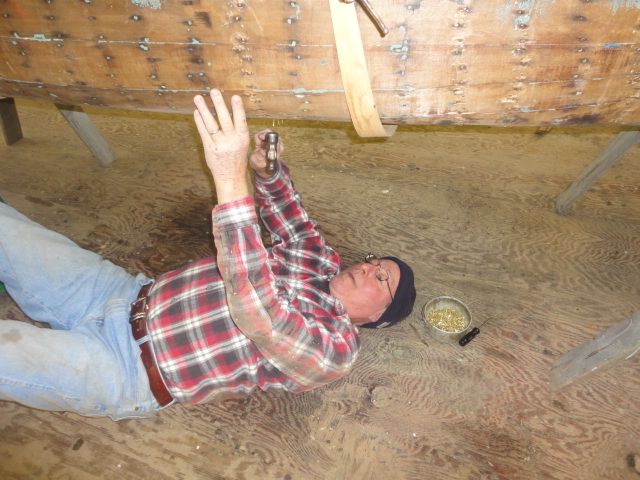
The OCTA with 12 new ribs, it was a tough morning for two old guys, but the result is very incouraging,
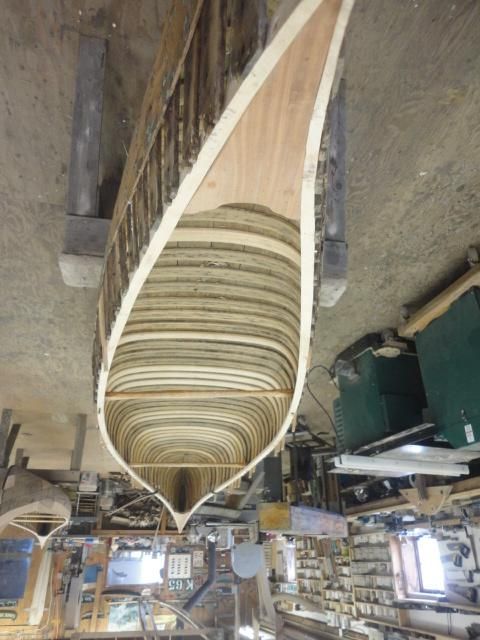
I'm off to the toboggan races in Camden, Maine Thursday so Bob will be installing plank then, and next week we should be sanding and varnishing, looking forward to that.
Bob fitting in a new rib

Me hammering in new tacks while Bob held the clinching iron on the inside to clinch the tack onto the new rib inside the canoe

The OCTA with 12 new ribs, it was a tough morning for two old guys, but the result is very incouraging,

Robin, are you racing? Were we not in Florida I would be teamed with my wacky 70 yo neighbor lady who loves things that dive.
More to topic Did you get your clinching iron from Rollin? Also we have to reclinch a lot of tacks and I have no idea how many thousand to buy. We can go to his place.
Hubby says he usually when replacing tacks and reclinching turns the boat on its side so you are not at risk of getting a nail in your mouth or eye. He learned that trick from Tom MacKenzie who can't lay on the floor on his back and Ts wife Karen who just won't
More to topic Did you get your clinching iron from Rollin? Also we have to reclinch a lot of tacks and I have no idea how many thousand to buy. We can go to his place.
Hubby says he usually when replacing tacks and reclinching turns the boat on its side so you are not at risk of getting a nail in your mouth or eye. He learned that trick from Tom MacKenzie who can't lay on the floor on his back and Ts wife Karen who just won't
Last edited:
My daughter is on a 4 women toboggan team. I worked on her sled and made it wide enough and put a wax over pine tar finish (as per HOOP's instructions), we might not win but they should be competitive.
If I where doing the canoe alone, I would have had the canoe upside down and drove the tacks in that way, but you have to watch that the ribs don't move. Or you can do it right side up, but the tack driving is more difficult.
I never did it on my back like that, but Bob needed to rest his back at that point and I thought if he sat and held the iron it would be more comfortable for him. We also had an issue with some new ribs not tight at the chine curve, so Bob was able to keep an eye on them while I nailed. Never again though, almost swallowed a tack, crap was falling in my face, up and down, up and down, UGH, I was tired at the end of the day.
We use Skyuler's
If I where doing the canoe alone, I would have had the canoe upside down and drove the tacks in that way, but you have to watch that the ribs don't move. Or you can do it right side up, but the tack driving is more difficult.
I never did it on my back like that, but Bob needed to rest his back at that point and I thought if he sat and held the iron it would be more comfortable for him. We also had an issue with some new ribs not tight at the chine curve, so Bob was able to keep an eye on them while I nailed. Never again though, almost swallowed a tack, crap was falling in my face, up and down, up and down, UGH, I was tired at the end of the day.
We use Skyuler's
Here's a couple pics from this mornings work.
We first posed for a group picture and hug,
Bob on left, me on right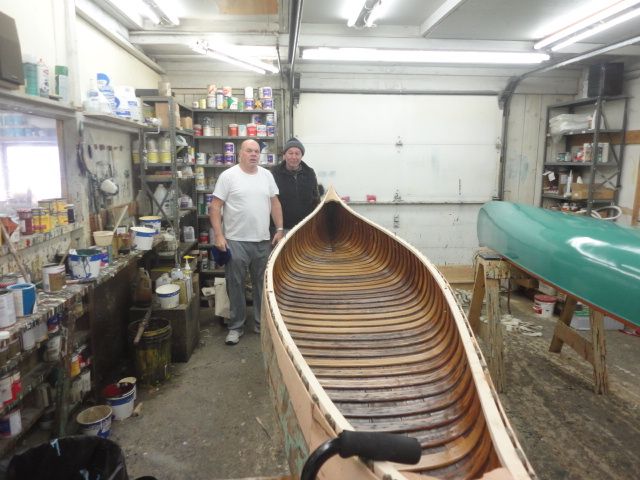
Then we began scuffing the second coat of varnish,
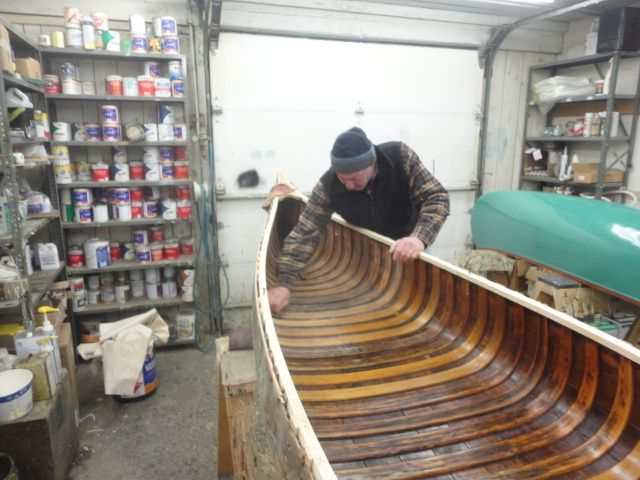
The first two coats where done and we brought out the more expensive Epifanes for the last two coats. Here is the canoe with a wet first coat of Epifanes. We go back Friday and add the second coat of Epifanes, then set the canoe in an envelop of canvas, which is stretched with come-alongs and weighed down with rocks for a wrinkle free fit, wait over-night and staple the canvas and hopefully put the first coat of filler on Monday night.
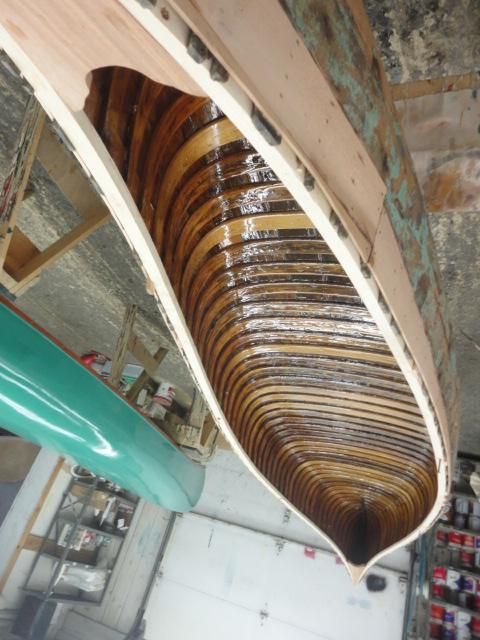
BTW, That canoe next to Bob's today has just received it's second coat of paint. The first two or three coats get heavily sanded, so the paint color is really not that important, the paint just fills the dimples and builds up a base.
For guys like us, doing our own restoration, Skyuler mixes left over paint from other restorations and sells it to us cheap. Maybe someone painting a "show boat" would object, but this canoe will be used with our grandchildren's fun in mind, so the paint is important, but not critical. The final two coats will be of the color Bob chooses from an unopened can, but the first two or three coats will be any ones guess as far as color.
That canoe next to Bob's will be a nice forest green from what I have been told.
We first posed for a group picture and hug,
Bob on left, me on right

Then we began scuffing the second coat of varnish,

The first two coats where done and we brought out the more expensive Epifanes for the last two coats. Here is the canoe with a wet first coat of Epifanes. We go back Friday and add the second coat of Epifanes, then set the canoe in an envelop of canvas, which is stretched with come-alongs and weighed down with rocks for a wrinkle free fit, wait over-night and staple the canvas and hopefully put the first coat of filler on Monday night.

BTW, That canoe next to Bob's today has just received it's second coat of paint. The first two or three coats get heavily sanded, so the paint color is really not that important, the paint just fills the dimples and builds up a base.
For guys like us, doing our own restoration, Skyuler mixes left over paint from other restorations and sells it to us cheap. Maybe someone painting a "show boat" would object, but this canoe will be used with our grandchildren's fun in mind, so the paint is important, but not critical. The final two coats will be of the color Bob chooses from an unopened can, but the first two or three coats will be any ones guess as far as color.
That canoe next to Bob's will be a nice forest green from what I have been told.
Robin, I'm loving this thread. Must say that the deck cutout pattern looks very classy. Along with SG's and Mem's strippers, it looks like it'll be a bumper crop of fresh canoes hitting the water this season. Thanks for keeping us updated. I'm certainly finding it therapeutic.
Gee, you are infecting me with the wood/canvas bug. The restoration looks beautiful. I have several boxes of different length brass tacs/nails, and I have a clinching iron too. I've also got a couple of old hulls around…….hmmmmm
I wish I didn't live so darn far away from all the good stuff that's going on. I'd love to be in the thick of it. I'd do all the grunt work just to get close enough to watch. Can't wait to see some canvas stretching on this baby.
Hey Rippy, I still have 3 project boats in the queue, how's about I send you one?
Hey Rippy, I still have 3 project boats in the queue, how's about I send you one?
I wouldn't know what to do with it with out one of you wood canvas crafts persons to guide me through the repair. I am amazed at the before and after pictures you people post up.
Well, I missed yesterdays shop day, shoveled snow off my house and canoe shop roofs Sunday and it just knocked me out. So Bob stapled the canvas onto the canoe by himself. Schuyler had stretched the canvas Saturday night and dropped the canoe in Sunday morning, filled it with rocks and by Monday morning, the canvas was wrinkle free and stretched tight around the canoe.
(this is not Bob's canoe but this is what the canvas stretching looks like at the shop)
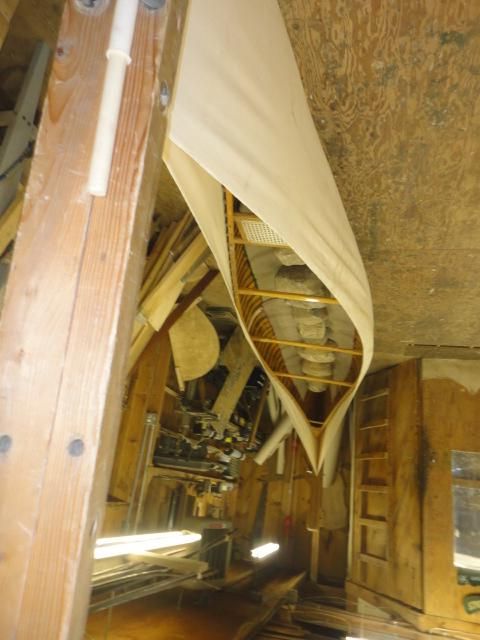
Today we moved the canoe into the paint room where we applied the first of 4 coats of Gluvit. Schuyler uses only Gluvit epoxy in his shop to fill the canvas, vs. the traditional fillers like Old Town makes.
The hull and canvas looked good, none of the bulges or bumps that where evident when the canoe entered the shop a few weeks ago. A complete hull sanding shortly before being placed into the canvas was the final treatment after all the new ribs and planks, inwales and decks.
Shortly before we applied the filler,
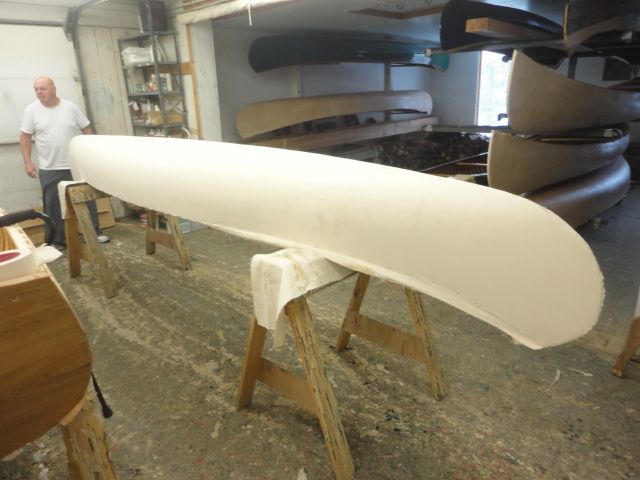
Bob checking the end where the canvas is folded and stapled, a tricky spot where flaws can show up.
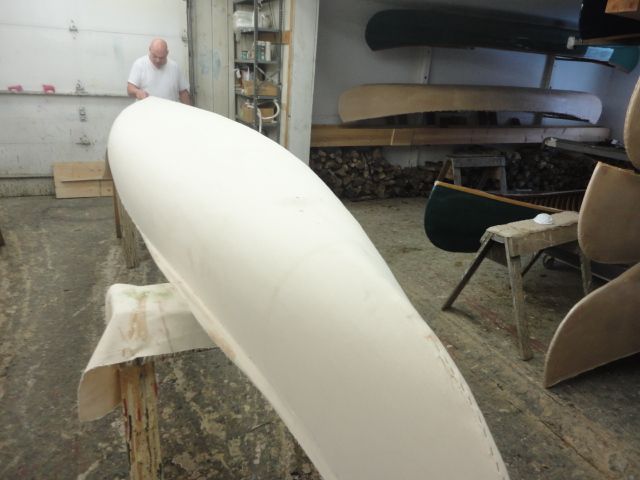
Me applying the filler with a brush.
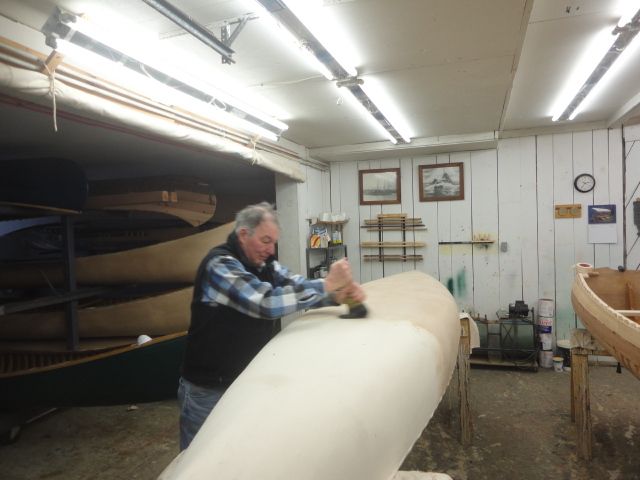
Business is good, these canoes are in various stages of the 4 coats of filler required and most are being restored by the owners. Come late March, everyone needs to be out, Schuyler gets busy and needs all the space for his customers restorations. Wood Canvas canoes are alive and well!
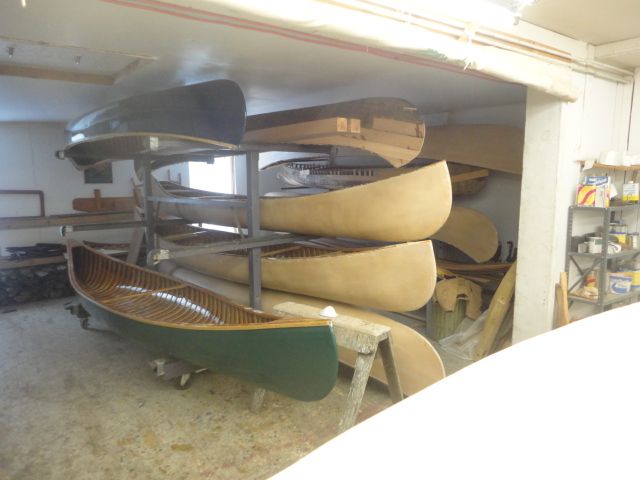
(this is not Bob's canoe but this is what the canvas stretching looks like at the shop)

Today we moved the canoe into the paint room where we applied the first of 4 coats of Gluvit. Schuyler uses only Gluvit epoxy in his shop to fill the canvas, vs. the traditional fillers like Old Town makes.
The hull and canvas looked good, none of the bulges or bumps that where evident when the canoe entered the shop a few weeks ago. A complete hull sanding shortly before being placed into the canvas was the final treatment after all the new ribs and planks, inwales and decks.
Shortly before we applied the filler,

Bob checking the end where the canvas is folded and stapled, a tricky spot where flaws can show up.

Me applying the filler with a brush.

Business is good, these canoes are in various stages of the 4 coats of filler required and most are being restored by the owners. Come late March, everyone needs to be out, Schuyler gets busy and needs all the space for his customers restorations. Wood Canvas canoes are alive and well!

Last edited:
Really nice stuff. So the epoxy filler...I've never heard of it....does it dry with some flexibility, or does it make the canvas hard? Enquiring minds need to know!
G
Guest
Guest
I'm really enjoying, and learning so much in this thread. Thanks Robin.
Well, I missed yesterdays shop day, shoveled snow off my house and canoe shop roofs Sunday and it just knocked me out. So Bob stapled the canvas onto the canoe by himself. Schuyler had stretched the canvas Saturday night and dropped the canoe in Sunday morning, filled it with rocks and by Monday morning, the canvas was wrinkle free and stretched tight around the canoe.
(this is not Bob's canoe but this is what the canvas stretching looks like at the shop)

Gotta love how high-tech the canvas stretching process is. Seriously... it's so fitting that a wood and canvas canoe is being refurbished using such a low tech improvised method... love it.
Gluvit dries hard. It requires 4 coats, it used to be 1st coat takes 1 day, 2nd coat 2 days, 3rd coat 3 days, 4th coat 4 days but you could still work on the canoe during the 4 day waiting period, gunnels, thwarts, seats, final coat of Varnish. Schuyler thinks they have changed the formula a little cause the drying time has increased, although we are going back today to apply the second coat with a 24 hr wait.Really nice stuff. So the epoxy filler...I've never heard of it....does it dry with some flexibility, or does it make the canvas hard? Enquiring minds need to know!
I'll post some pictures later, but the second, 3rd and 4th coats go on with a plastic spreader or squeegee type maneuver. You just pour a 2" puddle down the keel line and work your way down the canoe trying not to leave any lines. The first coat took a little over 1/2 a gallon, second coat less than a quart., third and fourth less than a quart.
Here is the Jamestown Distributors details:
http://www.jamestowndistributors.co...2091&engine=adwords!6456&keyword=gluvit_epoxy
The hull remains flexible inside the canvas cocoon, no epoxy makes it threw the canvas. If you removed the staples, the hull could be lifted out of the canvas.
Schuyler adds a cup of some material to the 2,3,4th cans of Gluvit to make it sand-able, otherwise it would be near impossible to sand. I will get it's name today, I forgot what he called it.
Those 3 tan canoes in the last picture are in various stages of receiving gluvit. The top one has 1 coat and feels rough like 150 grit sandpaper, the bottom has had 3 coats and feels much smoother.
Today we sanded the canoes first coat of Filler with 40 grit, just enough to knock off the edge but not too smooth. Bob sanding.....
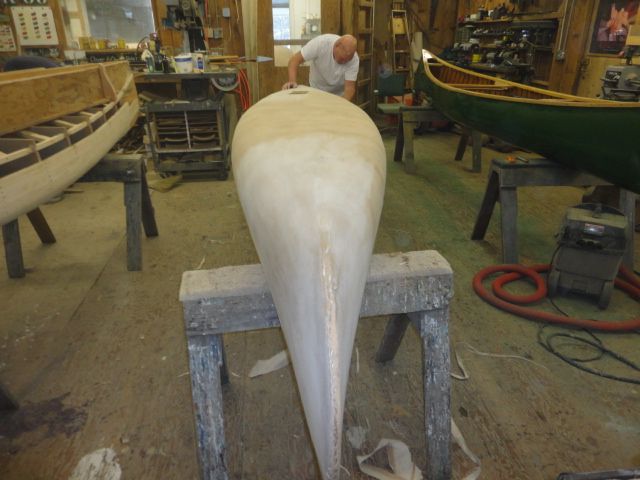
Second coat of Gluvit epoxy spread across Bobs Old Town
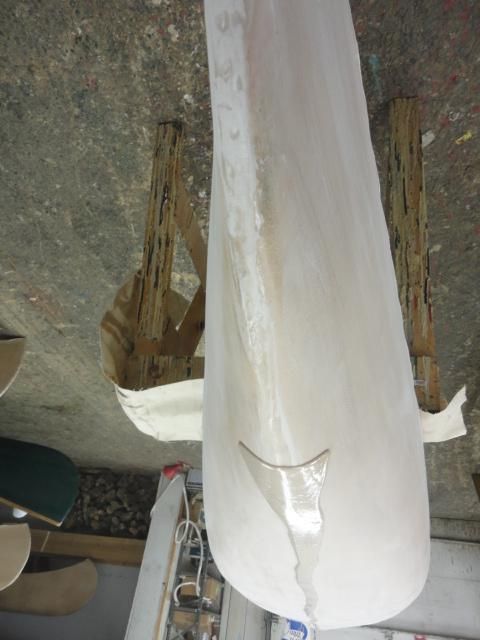
Schuyler spreading Gluvit on another canoe.

A few other canoes in the shop,
A form being built for a Chestnut Fox by Schuyler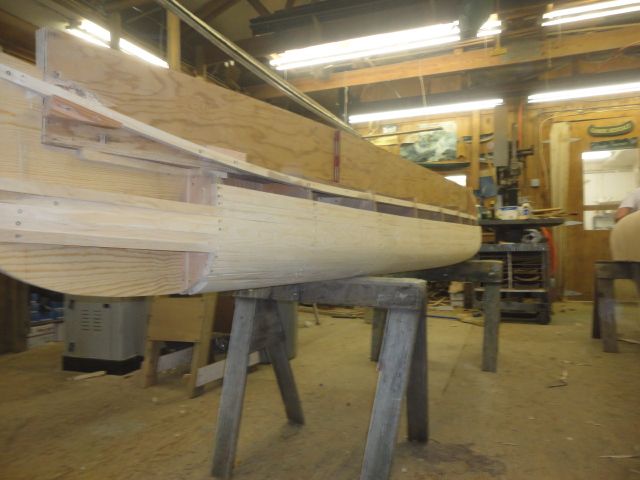
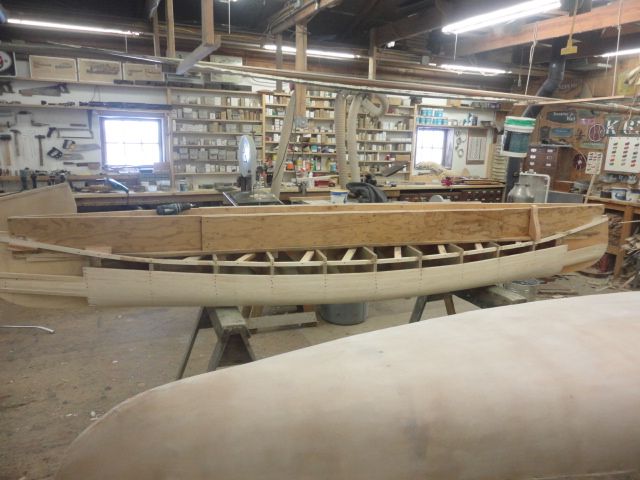
A 20' Chestnut which was cut in half from a falling tree during hurricane Sandy. The owner turned it into a 16 footer with the help of Schuyler

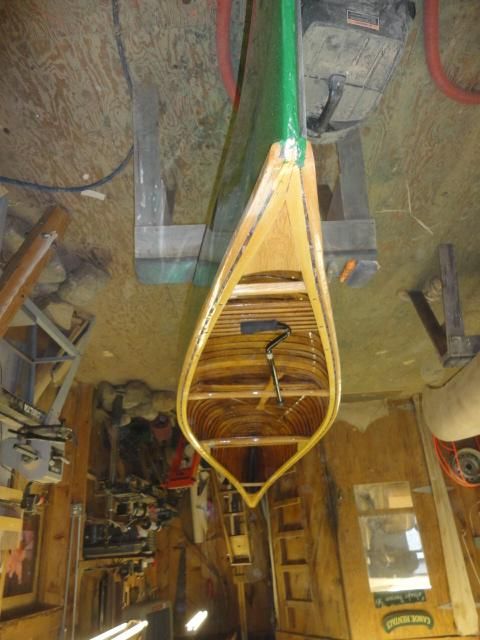
A Keewaydin canoe, a veteran of many canoe trips with Keewaydin campers and it has been restored by Schuyler more than once, getting ready for a new season.

Another good day in the shop.

Second coat of Gluvit epoxy spread across Bobs Old Town

Schuyler spreading Gluvit on another canoe.

A few other canoes in the shop,
A form being built for a Chestnut Fox by Schuyler


A 20' Chestnut which was cut in half from a falling tree during hurricane Sandy. The owner turned it into a 16 footer with the help of Schuyler


A Keewaydin canoe, a veteran of many canoe trips with Keewaydin campers and it has been restored by Schuyler more than once, getting ready for a new season.

Another good day in the shop.
So the last time I filled a canvas canoe, it was a gunky kind of stuff we rubbed in over hours with an oven mitt. I seem to recall it was a pretty labour intensive endeavour that lasted a few days. Is this Gluvit stuff something new? Is it what everyone is using now instead of traditional filler? It sounds pretty good, and might convince me to recanvas a canoe I have right now.
Mem, I had started a thread on the Wooden Canoe forums a while back and the topic turned to this Gluvit epoxy finish. One canoe builder who uses it extensively responded with a pro's and con's list that might be useful to you. Here's the link. The relevant info is in the last post on page two written by Dylan Schoelzel of Salmon Falls Canoe. Seems like most W/C folks haven't switched from traditional filler due to the higher cost but this system doesn't need the many weeks of curing before it gets painted so the boat gets in the water faster.
I still make my own classic filler, but I am finding it more difficult to find "oil based" enamel paint, which is necessary so it mixes with the linseed oil. I do need to wait a minimum of 4 weeks for the filler to cure. The Gluvit looks interesting, but at $140 US a gallon, not really affordable for me.
The fast turn around is probably why Schuyler uses Gluvit, not sure about this, but just my observation. He charges us $110 a gallon, I have used it with good results.
Last year I bought out Schuyler's left-over Old Town traditional filler, about enough to do 3 canoes. It was tough getting it mixed, but after that it went on pretty easy. 3 coats around the canoe with a heavy brush, non stop, rubbing it in with a canvas glove after 1st, 2nd and 3rd coats. Then I put the two canoes on the rack last August and let them sit for a month.
They are still sitting, but will be finished this spring.
Last year I bought out Schuyler's left-over Old Town traditional filler, about enough to do 3 canoes. It was tough getting it mixed, but after that it went on pretty easy. 3 coats around the canoe with a heavy brush, non stop, rubbing it in with a canvas glove after 1st, 2nd and 3rd coats. Then I put the two canoes on the rack last August and let them sit for a month.
They are still sitting, but will be finished this spring.
Similar threads
- Replies
- 8
- Views
- 376
